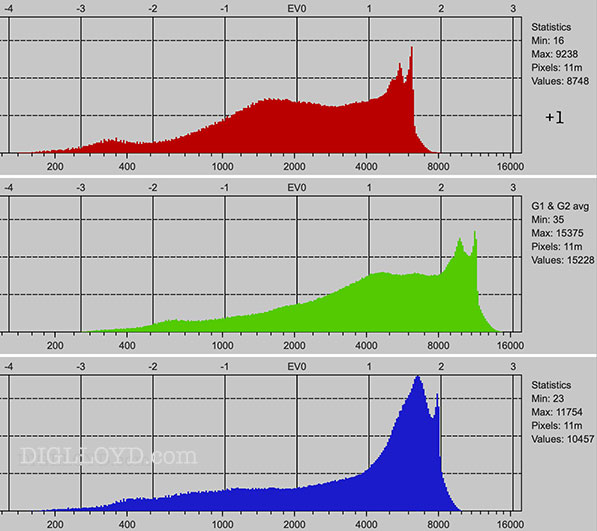“Baseline Exposure” Boost in RAW Converters can Whack Color

Baseline exposure value = how much to adjust brightness of a RAW file in order to generate an image the same brightness as a JPEG that camera would have produced.
Is baseline exposure boost yet another example of making things worse and adding complexity in order to mimic a JPEG?
Adobe Camera Raw and other raw converters silently apply this boost when raw converting. This can affect color and highlight detail.
Below, the color shifts subtly at 2nd-to-right, and then in a big way at right. Which means my perfect ETTR exposure is not perfect, but blown. Which cannot be told from the histogram.
This might not be the only issue: sensor non-linearity as the capture gets brighter can also shift color.
With Sony A7R V, I am seeing capture values up to 25000 in the 15-bit files. And yet capture values in the 14000+ range are causing color shifts.
It turns out that ETTR exposure is far more complicated than I had belleved.
ETTR: Too Much of a Good Thing? HARD to Get it Right
Baseline exposure values for Sony, Nikon, Fujifilm
Here is what I obtained for baseline exposure, converted various NEF/RAF/ARW/etc files to DNG first, as explained below by Alex Tutubalin further below.
(!) These figures can change when certain camera settings are in force eg Dynamic Range expansion. If you are shooting RAW, turn off most/all such features to avoid inconsistent expectations, or check all combinations.
exiftool -make -model -iso -baselineexposure -r -ext dng *.dng
Camera ISO Baseline Exposure Fujifilm GFX100 II 80 -0.01 Fujifilm GFX100S 100 -0.01 Fujifilm GFX100S 50 -1.01
NIKON Z8 Lo1 32 -0.8 NIKON Z8 Lo0.7 40 -0.46 NIKON Z8 Lo0.3 50 -0.13 NIKON Z8 64+ 0.2 NIKON Zf 100+ 0.2
Sony A7R V 50 -0.65 Sony A7R V 64 -0.65 Sony A7R V 80 -0.65 Sony A7R V 100+ 0.35
Can using a sub-ISO value like pseudo-ISO 50 on Sony A7R V avoid the issue, since the baseline exposure is negative? Nope— I tried it—it makes no difference, so I don’t know what Adobe Camera Raw is doing with it. Or maybe something else is going on such as sensor nonlinearity—I don’t know.
Continues below...

Nikon Z8 + Nikon NIKKOR Z MC 105mm f/2.8 VR S Macro
[low-res image for bot]
Alex Tutubalin of LibRAW writes:
1) Adobe tools (silently) applies exposure correction to RAWs: https://photographylife.com/adobes-silent-exposure-compensation
The idea behind it is simple:
- RAW middle point is not specified by any standard (the ISO-standard on ISO-sensitivity for digital cameras: operates with out-of-camera JPEGs only and explicitly denies RAW ISO-sensitivity determination).
- So camera vendors may 'underexposure' for RAW and correct this via in-camera processing (lifting midpoint).
- So, to match Adobe tools' rendering with in-camera JPEG, RAW processing should do the same: lift the midpoint.This is called 'baseline exposure' in DNG specs; In most cases this is positive correction.
So, ETTR-exposed RAW image will be silently 'exposure corrected' (also: non-linear curves applied; see below) in Adobe Camera Raw or Lightroom.
Here are several our articles/howtos on this topic:
a) How to derive hidden exposure applied by converter:
https://www.rawdigger.com/howtouse/deriving-hidden-ble-compensationa-2) FastRawViewer also displays 'Baseline exposure' in EXIF panel if enabled via EXIF display preferences.
b) How to force no adjusted processing:
https://www.rawdigger.com/howtouse/overriding-raw-converter-default-adjustments-settingsc) How to force FastRawViewer to not apply Adobe's correction (applied by default to match Adobe tools): https://www.fastrawviewer.com/blog/fastrawviewer1-7-new-view-mode
2) Also, we've implemented 'Forced Adobe noncorrected mode' in FastRawViewer, see corresponding section in the manual:
https://updates.fastrawviewer.com/data/FastRawViewer2-Manual-ENG.pdf#page=125Finally: although ETTR looks a way to deliver better signal/noise, the entire workflow is very hard due to decisions made by Camera Vendors (let's underexpose and correct in JPEG) and Software vendors (our 'default' rendered image should match OOC-JPEG)
DIGLLOYD: once again the anachronistic film-era demon strikes: degrading the potential of RAW files and their processing so that the casual user can have JPEGs. Gah!























